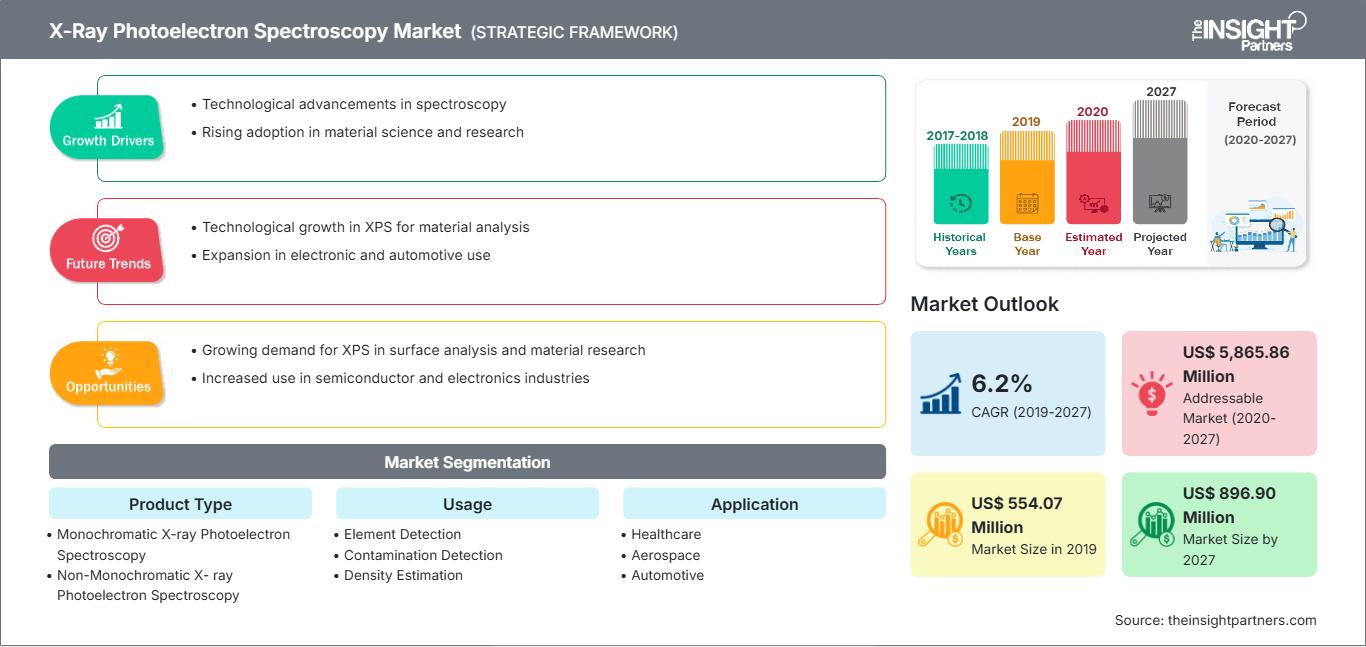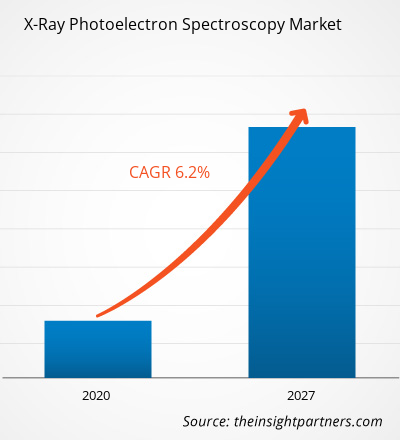Der Markt für Röntgen-Photoelektronenspektroskopie wurde 2019 auf 554,07 Millionen US-Dollar geschätzt und soll von 2020 bis 2027 mit einer durchschnittlichen jährlichen Wachstumsrate von 6,2 % wachsen und bis 2027 896,90 Millionen US-Dollar erreichen.
Die Röntgen-Photoelektronenspektroskopie (XPS) ist eine quantitative spektroskopische Technik, mit der die Elementzusammensetzung, die Summenformel, der chemische Zustand und der elektronische Zustand der in einer bestimmten Probe vorhandenen Elemente gemessen werden. Der globale Markt für Röntgen-Photoelektronenspektroskopie wird von Faktoren wie der steigenden Nachfrage nach Hochleistungsmaterialien und der zunehmenden Finanzierung von Forschung und Entwicklung durch private Einrichtungen angetrieben. Der Mangel an qualifizierten Fachkräften dürfte das Marktwachstum im Prognosezeitraum jedoch bremsen. Allerdings werden Entwicklungsmöglichkeiten in Schwellenländern voraussichtlich in naher Zukunft erhebliche Wachstumschancen eröffnen und die Marktanteile der Branchenakteure verbessern.
Markteinblicke: Steigende Nachfrage nach Hochleistungsmaterialien
Röntgen-Photoelektronenspektroskopie (XPS) ist eine Technik zur Analyse der Oberflächenchemie eines Materials. Die XPS-Technik ist auch als Elektronenspektroskopie zur chemischen Analyse (ESCA) bekannt und ist eine etablierte Methode zur chemischen Charakterisierung von Materialoberflächen. Die Lieferanten und Hersteller von technischen und kommerziellen Textilien konzentrieren sich auf die Entwicklung von XPS als ideales Werkzeug zur Unterstützung der Optimierung und Entwicklung der von den Verbrauchern nachgefragten Arten von Oberflächenbeschichtungen oder -behandlungen. Polymernetze, beispielsweise aus Polyester und Polypropylen, werden zur chirurgischen Reparatur von Hernien und anderen Weichteildefekten verwendet.
Passen Sie diesen Bericht Ihren Anforderungen an
Sie erhalten kostenlos Anpassungen an jedem Bericht, einschließlich Teilen dieses Berichts oder einer Analyse auf Länderebene, eines Excel-Datenpakets sowie tolle Angebote und Rabatte für Start-ups und Universitäten.
Markt für Röntgen-Photoelektronenspektroskopie: Strategische Einblicke

-
Holen Sie sich die wichtigsten Markttrends aus diesem Bericht.Dieses KOSTENLOSE Beispiel umfasst Datenanalysen, die von Markttrends bis hin zu Schätzungen und Prognosen reichen.
Obwohl in der Chirurgie Netzmaterialien verwendet werden, kann ihre Implantation mit schweren Infektionen einhergehen. Um die Infektionsraten solcher Netze zu senken, müssen ihre Oberflächeneigenschaften verbessert werden. Außerdem können viele Probleme im Zusammenhang mit modernen Materialien gelöst werden, indem man die chemischen und physikalischen Wechselwirkungen versteht, die an den Grenzflächen der Schichten oder Oberflächen eines Materials auftreten. Die Oberfläche beeinflusst Faktoren wie katalytische Aktivität, Korrosionsraten, Benetzbarkeit, Hafteigenschaften, Kontaktpotenzial und Versagensmechanismen. Daher wird die steigende Nachfrage nach Hochleistungsmaterialien den Markt für Röntgen-Photoelektronenspektroskopie im Prognosezeitraum proportional ansteigen lassen.
Einblicke in Produkttypen
Zu den Produkttypsegmenten des Marktes für Röntgen-Photoelektronenspektroskopie gehören die monochromatische und die nicht-monochromatische Röntgen-Photoelektronenspektroskopie. Das Segment der monochromatischen Röntgen-Photoelektronenspektroskopie nimmt den größten Anteil am globalen Markt für Röntgen-Photoelektronenspektroskopie ein. Die monochromatische Röntgen-Photoelektronenspektroskopie verwendet eine monochromatische Aluminium-Röntgenquelle, die ein breites Spektrum an Proben analysieren kann. Bei Verwendung eines Monochromators ist der Abstand zwischen Röntgenquelle und Probe größer als bei einer nicht-monochromatischen Quelle, wodurch das Risiko einer Probenbeschädigung geringer ist. Daher bietet die monochromatische Röntgen-Photoelektronenspektroskopie viele Vorteile gegenüber der nicht-monochromatischen Röntgen-Photoelektronenspektroskopie.
Nutzungseinblicke
Zu den Nutzungssegmenten des Marktes für Röntgen-Photoelektronenspektroskopie gehören Elementdetektion, Dichteschätzung, Kontaminationserkennung, Bestimmung empirischer Formeln und mehr. Der Markt für Elementerkennung verzeichnete 2019 den höchsten Anteil und dürfte im Prognosezeitraum aufgrund verschiedener Anwendungen in unterschiedlichen Bereichen ein bemerkenswertes Wachstum verzeichnen.
Gemessen am Marktanteil liegt die Kontaminationserkennung im Anwendungssegment an zweiter Stelle. Organische und anorganische Verunreinigungen können mittels XPS erkannt werden. Oberflächenanalysen von Verbundmetallen, Gläsern, Gasen und stark absorbierten Flüssigkeiten können mithilfe von XPS-Anwendungen durchgeführt werden.
Anwendungseinblicke
Das Anwendungssegment dieser Studie umfasst das Gesundheitswesen, die Luft- und Raumfahrt, die Automobilindustrie und andere. Die Anwendungen im Gesundheitsmarkt umfassen Zell-/Bakterien-/Gewebeanalysen, die Charakterisierung von Chemikalien, die Immobilisierung von Antikörpern sowie die Untersuchung von Proteinen und Peptiden. Im Elektronikmarkt wird XPS zur Analyse und Charakterisierung von Zusammensetzungen eingesetzt. XPS wird zur Durchführung von Oberflächenfilmanalysen in der Luft- und Raumfahrt, der Automobilindustrie und im Verpackungsmarkt verwendet.
Das Segment Gesundheitswesen hatte im Anwendungssegment den größten Marktanteil und wird den Markt im Prognosezeitraum voraussichtlich dominieren. Der große Anteil ist auf strenge Vorschriften für minimale Medikationsfehler und zulässige Schadstoffwerte in medizinischen Implantaten zurückzuführen.
Unternehmen verfolgen häufig Fusions- und Übernahmestrategien, um ihre Präsenz weltweit zu erweitern und die wachsende Nachfrage zu befriedigen. Marktteilnehmer verfolgen diese Strategie am häufigsten, um ihr Produktportfolio zu erweitern.
Die Marktteilnehmer im Markt für Röntgen-Photoelektronenspektroskopie verfolgen eine Strategie der Expansion und Investition in Forschung und Entwicklung, um ihren Kundenstamm weltweit zu vergrößern und ihren Markennamen global zu behaupten.
Röntgen-Photoelektronenspektroskopie
Regionale Einblicke in den Markt für Röntgen-PhotoelektronenspektroskopieDie Analysten von The Insight Partners haben die regionalen Trends und Faktoren, die den Markt für Röntgen-Photoelektronenspektroskopie im Prognosezeitraum beeinflussen, ausführlich erläutert. In diesem Abschnitt werden auch die Marktsegmente und die geografische Verteilung der Röntgen-Photoelektronenspektroskopie in Nordamerika, Europa, im asiatisch-pazifischen Raum, im Nahen Osten und Afrika sowie in Süd- und Mittelamerika erörtert.
Umfang des Marktberichts zur Röntgen-Photoelektronenspektroskopie
| Berichtsattribut | Einzelheiten |
|---|---|
| Marktgröße in 2019 | US$ 554.07 Million |
| Marktgröße nach 2027 | US$ 896.90 Million |
| Globale CAGR (2019 - 2027) | 6.2% |
| Historische Daten | 2017-2018 |
| Prognosezeitraum | 2020-2027 |
| Abgedeckte Segmente |
By Produkttyp
|
| Abgedeckte Regionen und Länder |
Nordamerika
|
| Marktführer und wichtige Unternehmensprofile |
|
Marktteilnehmerdichte im Bereich Röntgen-Photoelektronenspektroskopie: Auswirkungen auf die Geschäftsdynamik verstehen
Der Markt für Röntgen-Photoelektronenspektroskopie wächst rasant. Die steigende Nachfrage der Endverbraucher ist auf Faktoren wie veränderte Verbraucherpräferenzen, technologische Fortschritte und ein stärkeres Bewusstsein für die Produktvorteile zurückzuführen. Mit der steigenden Nachfrage erweitern Unternehmen ihr Angebot, entwickeln Innovationen, um den Bedürfnissen der Verbraucher gerecht zu werden, und nutzen neue Trends, was das Marktwachstum weiter ankurbelt.

- Holen Sie sich die Markt für Röntgen-Photoelektronenspektroskopie Übersicht der wichtigsten Akteure
Globaler Markt für Röntgen-Photoelektronenspektroskopie – nach Produkttyp
- Monochromatische Röntgen-Photoelektronenspektroskopie
- Nicht-monochromatische Röntgen-Photoelektronenspektroskopie
Globaler Markt für Röntgen-Photoelektronenspektroskopie – nach Verwendung
- Elementerkennung
- Kontaminationserkennung
- Bestimmung empirischer Formeln
- Dichteschätzung
- Sonstige
Globaler Markt für Röntgen-Photoelektronenspektroskopie – Nach Anwendung
- Gesundheitswesen
- Luft- und Raumfahrt
- Automobil
- Sonstige
Markt für Röntgen-Photoelektronenspektroskopie – nach Geografie
-
Nordamerika
- USA
- Kanada
- Mexiko
-
Europa
- Frankreich
- Deutschland
- Italien
- Großbritannien
- Russland
- Restliches Europa
-
Asien-Pazifik
- China
- Indien
- Südkorea
- Japan
- Australien
- Restlicher Asien-Pazifik-Raum
-
Naher Osten und Afrika
- Südafrika
- Saudi-Arabien
- VAE
- Rest des Nahen Ostens und Afrika
-
Südamerika
- Brasilien
- Argentinien
- Rest Südamerika
Firmenprofile
- Shimadzu Corporation
- Physical Electronics, Inc.
- Thermo Fisher Scientific Inc
- Japan Electron Optics Laboratory Company, Limited
- Revera Inc.
- SPECS GmbH
- PREVAC
- Scienta Omicron
- Staib Instruments
- OCI Vacuum Microengineering Inc.
- Historische Analyse (2 Jahre), Basisjahr, Prognose (7 Jahre) mit CAGR
- PEST- und SWOT-Analyse
- Marktgröße Wert/Volumen – Global, Regional, Land
- Branchen- und Wettbewerbslandschaft
- Excel-Datensatz
Aktuelle Berichte
Verwandte Berichte
Erfahrungsberichte
Grund zum Kauf
- Fundierte Entscheidungsfindung
- Marktdynamik verstehen
- Wettbewerbsanalyse
- Kundeneinblicke
- Marktprognosen
- Risikominimierung
- Strategische Planung
- Investitionsbegründung
- Identifizierung neuer Märkte
- Verbesserung von Marketingstrategien
- Steigerung der Betriebseffizienz
- Anpassung an regulatorische Trends






















 Kostenlose Probe anfordern für - Markt für Röntgen-Photoelektronenspektroskopie
Kostenlose Probe anfordern für - Markt für Röntgen-Photoelektronenspektroskopie